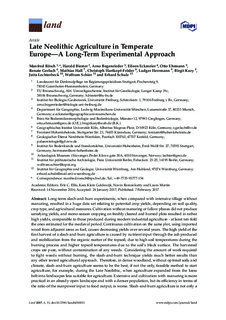Late Neolithic Agriculture in Temperate Europe — A Long-Term Experimental Approach
| dc.contributor.author | Rösch, Manfred | |
| dc.contributor.author | Biester, Harald | |
| dc.contributor.author | Bogenrieder, Arno | |
| dc.contributor.author | Eckmeier, Eileen | |
| dc.contributor.author | Ehrmann, Otto | |
| dc.contributor.author | Gerlach, Renate | |
| dc.contributor.author | Hall, Mathias | |
| dc.contributor.author | Hartkopf-Fröder, Christoph | |
| dc.contributor.author | Herrmann, Ludger | |
| dc.contributor.author | Kury, Birgit | |
| dc.contributor.author | Lechterbeck, Jutta | |
| dc.contributor.author | Schier, Wolfram | |
| dc.contributor.author | Schulz, Erhard | |
| dc.coverage.spatial | Europa | nb_NO |
| dc.date.accessioned | 2018-04-05T12:23:57Z | |
| dc.date.available | 2018-04-05T12:23:57Z | |
| dc.date.created | 2017-09-20T11:07:03Z | |
| dc.date.issued | 2017-02 | |
| dc.identifier.citation | Rösch, M. (2017) Late Neolithic Agriculture in Temperate Europe — A Long-Term Experimental Approach Land. 2017, 6 (1) | nb_NO |
| dc.identifier.issn | 2073-445X | |
| dc.identifier.uri | http://hdl.handle.net/11250/2492866 | |
| dc.description.abstract | Long-term slash-and-burn experiments, when compared with intensive tillage without manuring, resulted in a huge data set relating to potential crop yields, depending on soil quality, crop type, and agricultural measures. Cultivation without manuring or fallow phases did not produce satisfying yields, and mono-season cropping on freshly cleared and burned plots resulted in rather high yields, comparable to those produced during modern industrial agriculture - at least ten-fold the ones estimated for the medieval period. Continuous cultivation on the same plot, using imported wood from adjacent areas as fuel, causes decreasing yields over several years. The high yield of the first harvest of a slash-and-burn agriculture is caused by nutrient input through the ash produced and mobilization from the organic matter of the topsoil, due to high soil temperatures during the burning process and higher topsoil temperatures due to the soil’s black surface. The harvested crops are pure, without contamination of any weeds. Considering the amount of work required to fight weeds without burning, the slash-and-burn technique yields much better results than any other tested agricultural approach. Therefore, in dense woodland, without optimal soils and climate, slash-and-burn agriculture seems to be the best, if not the only, feasible method to start agriculture, for example, during the Late Neolithic, when agriculture expanded from the loess belt into landscapes less suitable for agriculture. Extensive and cultivation with manuring is more practical in an already-open landscape and with a denser population, but its efficiency in terms of the ratio of the manpower input to food output, is worse. Slash-and-burn agriculture is not only a phenomenon of temperate European agriculture during the Neolithic, but played a major role in land-use in forested regions worldwide, creating anthromes on a huge spatial scale. | nb_NO |
| dc.description.sponsorship | © 2017 the authors | nb_NO |
| dc.language.iso | eng | nb_NO |
| dc.publisher | MDPI | nb_NO |
| dc.relation.uri | http://www.mdpi.com/2073-445X/6/1 | |
| dc.rights | Navngivelse 4.0 Internasjonal | * |
| dc.rights.uri | http://creativecommons.org/licenses/by/4.0/deed.no | * |
| dc.subject | jordbruk | nb_NO |
| dc.subject | neolitikum | nb_NO |
| dc.subject | landbruk | nb_NO |
| dc.title | Late Neolithic Agriculture in Temperate Europe — A Long-Term Experimental Approach | nb_NO |
| dc.type | Journal article | nb_NO |
| dc.type | Peer reviewed | nb_NO |
| dc.description.version | publishedVersion | nb_NO |
| dc.subject.nsi | VDP::Matematikk og Naturvitenskap: 400::Basale biofag: 470 | nb_NO |
| dc.subject.nsi | VDP::Humaniora: 000::Arkeologi: 090 | nb_NO |
| dc.source.pagenumber | 17 | nb_NO |
| dc.source.volume | 6 | nb_NO |
| dc.source.journal | Land | nb_NO |
| dc.source.issue | 1 | nb_NO |
| dc.identifier.doi | 10.3390/land6010011 | |
| dc.identifier.cristin | 1495767 | |
| cristin.unitcode | 217,9,5,0 | |
| cristin.unitname | Avdeling fornminner | |
| cristin.ispublished | true | |
| cristin.fulltext | original | |
| cristin.qualitycode | 1 |
Tilhørende fil(er)
Denne innførselen finnes i følgende samling(er)
-
Articles (AmS) [145]
-
Publikasjoner fra CRIStin [4377]

